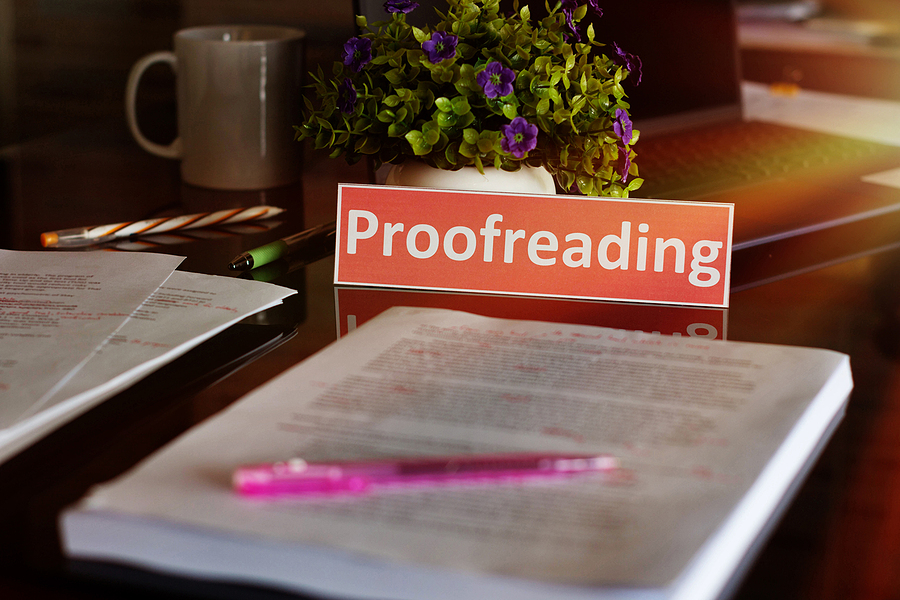Your employer or college lecturer might have told you that you must proofread your work before submitting it. It is quite possible that you have considered the following question – “do I really need to proofread my work?” A simple answer to that is writing and proofreading is dependent on one another so writing is unlikely to be successful unless it has been proofread.
What a lot of people mean when asked what proofreading is that it is the procedure used for checking through a written document for formatting, grammar and typographical mistakes. Proofreading should be the final job before the document is sent to be published. This could be a document that is loaded online, submitted as part of course work when undertaking a university degree, sent to a potential employer when applying for a job, or shared with another audience.
The kinds of mistakes are typically identified and corrected during proofreading.
When a document is ready for the proofreading phase, editing should have already taken place. This means the content should be well written, well organised, and easy to understand. The editing process does involve eliminating mistakes, but it also concentrates on ensuring the complete document makes sense.
A proofreader ensures that the final draft of a document has no grammatical mistakes such as wrong word choice, subject to verb agreement, incorrect use of punctuation, wrong spelling, typographical and formatting mistakes.
Small errors in any piece of writing can be disastrous and any of the following could happen:
1. Errors can lower the chances of your writing is accepted by a publisher.
The majority of those people working in publishing know what is correct grammar, punctuation, usage and spelling, so they can quickly spot any typos and language inconsistencies without even trying. If your document has many errors, it might not get any further than the editor’s eyes.
2. Errors could give a document an unprofessional look for both readers and publishers.
Even if the document has been accepted already by a publisher, if the editor had to spend a considerable amount of valuable time fixing mistakes, he or she may have lost the true meaning of the text and would certainly not have been too impressed by the document.
3. Errors can have an impact on product sales.
Readers who have to contend with reading a document about a product with a lot of mistakes are unlikely to recommend it to friends.
4. Errors may be costly.
If you need to pay somebody to edit and proofread your document, and you have failed to correct the punctuation, grammar, word usage and spelling yourself, you will be asked to pay more or somebody else to perform that task for you.
5. Errors can cause distractions.
If you are reading an article or book and even if the content is fantastic, if any mistakes are present in word usage, punctuation and spelling, it’s much too difficult to focus on understanding the document or book.
6. Errors may give rise to a bad reputation.
If a text, document or book hasn’t been proofread carefully by the potential publisher it may be released to the public with numerous typos and inconsistencies which could include errors in grammar, punctuation and word usage giving a poor image of the product.
Professionalism means good proofreading
If you are eager to see your book get published you need to have an edge over your competitors. If you want people to purchase what you have written, you must take the time to get it right.
Writing and proofreading checklist
These are 10 tips to proofread your writing
Scan the document, and ensure all spelling is correct. Changing the font can help catch errors more easily. Some of the most common errors are there/they’re/there, but also discrete/discreet, prosecute/persecute, and further/farther.
Make sure you have used the hyphen, em dash, and en dash correctly. The hyphen forms compound words, the en dash shows range, and the em dash is typically used to split up sentences.
Use spelling consistently so all names and terms are spelled the same in the whole document.
Consider language and tone so that word choices are appropriate for the intended audience and genre.
Check paragraphs flow nicely.
Make sure the tense maintains consistently throughout.
Make sure vocabulary is varied.
If there are many changes being made try to edit the text again and return to proofreading.
Take a break and return to the job with a clearer mind.
Go over the text with an automatic spell-checker and know when the suggested changes are correct.
Format the document to your style guide. This should include headers, margins, spacing, paragraphs, size and font type.
Double-check the spacing as writers commonly add two spaces between sentences and words. Words must have just a single space separating them, and also a single space separating sentences.
Read the complete document again.
Choosing a writing and proofreading service
If you need proofreading service to do your proofreading job, who you choose will depend on the type of document you want to be proofread as you will need a proofreader skilled in your type of document. This includes the following:
transactional documents;
scientific texts;
literary texts like poems and novels;
legal texts;
financial reports and documents;
emails;
business reports;
business letters.




